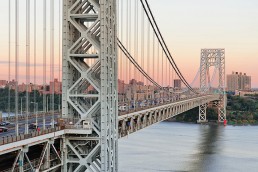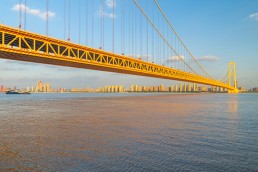© Sean PavoneBrooklyn Bridge 1883
Brooklyn Bridge 1883
The Bridge
The Brooklyn Bridge, over New York’s East River, is one of the landmark developments in bridge design and engineering. The 177m central span of the Menai Straits Bridge of 1826 in the UK gave way to a series of American suspension bridges and the iconic Brooklyn Bridge, with its 486m span, in 1883.
It was the first bridge to link Manhattan and Brooklyn and led to the latter officially becoming part of New York City in 1898.
John Augustus Roebling designed the bridge and developed a new way of building the suspension cable using individual steel wires. He was able to use this to full effect on Brooklyn to achieve the new world record central span. Unfortunately he died in the early stages of construction and his son Washington Roebling took over as Chief Engineer. He too suffered an accident on site but continued to oversee construction with his wife Emily.
The Brooklyn Bridge has a distinctive appearance with its vast Gothic towers and double arches and remains one of the most recognisable symbols of New York City.
Brooklyn Bridge
Connecting Brooklyn and Manhattan
Key Facts
Light rail / Metro rail / footbridge
Carries 6 lanes
Designated National Historic Landmark in 1964
Location
New York, USA
Across the East River
Between Brooklyn and Manhattan
Designers / Engineers
John Augustus Roebling
Washington Roebling
Description
Hybrid cable-stayed/suspension bridge
486.3m main span
1,833.7m total length
Main contractors
John A Roebling & Son
New York & Brooklyn Bridge Company
Construction
Began 2 January 1870
Opened 24 May 1883




































































